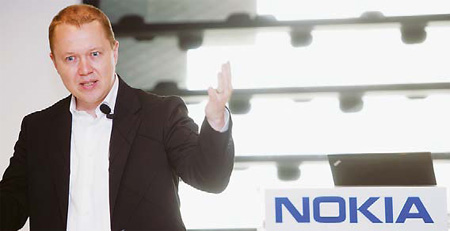
Marko Ahtisaari [Provided to China Daily] |
In order to fit the formation of a digital city, the boundary between the virtual world and reality becomes more vague with the increasing sophistication of mobile applications, according to Nokia's senior vice-president of design, Marko Ahtisaari.
Ahtisaari outlined his principal design concepts and personal experiences at a forum themed "Better Design, Better Life", recently held at the Finland Pavilion at the Expo 2010 Shanghai.
Ahtisaari is the son of former president of Finland and Nobel Peace Prize recipient, Martti Ahtisaari, and is recognized as the leader of innovative mobile culture.
"I think one key trend, which is also very common with the Expo, is the combination of human values and technology, which increase intuitiveness in the user interface and bigger screen displays on smart phones," Ahtisaari said.
Ahtisaari worked in the Insight and Foresight Strategy unit at Nokia before leaving in 2007 to launch Dopplr, a social networking service that allows users to create and update travel itineraries to share with contacts. Nokia acquired Dopplr in 2009, and Ahtisaari returned to the company.
"One of the cultural things about Nokia is that it has this high-tech, sophisticated technology with human creativity. They are not in conflict but rather both are optimized, and I think this is very important in the organization," he said.
By serving on the board of directors of Artek, a furniture design company, and Witness, a human rights organization, and being a part of the team behind Blyk, a free messaging mobile media, Ahtisaari has created boundary-crossing dialogue and innovations across many industries.
"I take a very broad outlook on design, combine the services, the product and the software with peculiar elements that I absorb from my other interests including society, culture and music," Ahtisaari said.
Ahtisaari also related design concepts with the Finland Pavilion, which emerges like an island from the surface of the water while inside visitors are led through exhibits featuring technological advancements, sustainable ecology and diverse cultures.
Ahtisaari said that Nokia's design principles focus on providing devices simple in appearance but with upgraded software.
"I prefer being able to use a mobile device with their heads up rather than down. Most current smart phones with touch screens require customers to use both hands to operate, while Nokia aims to give customers total mobility by being able to keep their heads up," said Ahtisaari.
He said that having another hand free can help with face-to-face communication.
Ahtisaari said he was confident in providing Chinese users with updated products covering low-, medium- and high-end mobile devices at reasonable prices.

